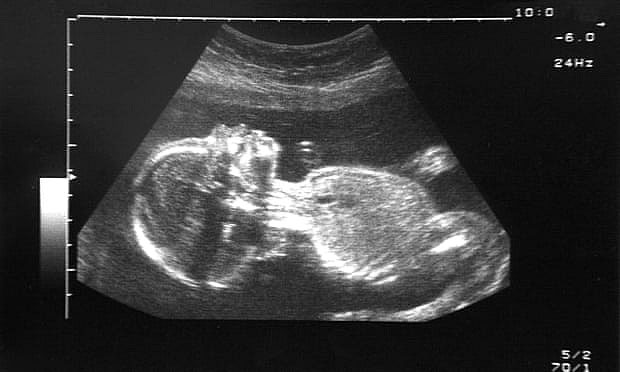Particles polluting the air 'squeeze' into the placenta?
These particles enter the placenta through the mother's breathing activity.
According to a new study published in Nature Communications, scientists have found tens of thousands of air-polluting particles in the placenta, showing that since birth, babies have been directly affected by Black carbon comes from combustion emissions.
Hurt mother and baby
In each placenta sample analyzed, experts found tens of thousands of tiny dust particles per square millimeter of tissue. These particles enter the placenta through the mother's breathing activity. This can cause problems such as premature birth, low birth weight and increased miscarriage. The research results show that the toxins in these particles are the cause of injury to mothers and babies, not just the inflammatory response caused by common pollution.

Environmental pollution affects the health of pregnant women and their unborn babies.
Specifically, the team used laser technology to examine the 25 placenta of non-smoking pregnant women living in the town of Hasselt, Belgium. It has lower levels of air pollution than the EU limits, but surpasses the standards set by the World Health Organization. They use an extremely short pulse laser, which helps black carbon particles emit a pale white light upon contact, thereby measuring the amount of particles in the placenta.

The team used laser technology to examine the 25 placenta of non-smoking pregnant women living in the town of Hasselt, Belgium.
As a result, the number of pollutant particles detected in the placenta correlates with the mother's condition: There are an average of 20,000 polluted nanoparticles per millimeter of the placental tissue mass of women who live near large roads, this figure for people living far from the road is an average of 10,000 grains / cubic millimeter of tissue. Experts also analyzed placental samples of miscarried fetuses and found contaminated particles in the 12-week-old fetus.

The more carbon women are exposed to during pregnancy, the greater the amount of carbon in the placenta.
Currently, scientists have not proven whether or not carbon black particles from the placenta attach to the fetus, as well as the health implications of these particles for mother and baby.
Dr. Yoel Sadovsky, at the University of Pittsburgh Medical Center, expert on placenta, who participated in the study, said.
'However, this finding is very important,' Mr. Yoel added.
The first report of contaminated particles in the placenta was presented at a conference in September 2018, by Professor Jonathan Grigg's research group, but the composition of these particles has not been determined. Scientists are currently analyzing fetal blood samples to determine if these particles are capable of damaging DNA.

Black carbon particles penetrate the placenta: Evidence shows that air pollution directly affects the fetus in the womb.
Pregnant women should proactively avoid crowded, smoky places
Professor Tim Nawrot of Hasselt University, Belgium, who led the study, said: 'It is very dangerous if the fetus is affected by air pollution. Lesions that occur during pregnancy can have life-long consequences for the baby. This is the most fragile, most vulnerable period in a person's life, when all internal organs are being formed and developed. To protect future generations, we must reduce pollution '.
According to him, governments are responsible for reducing air pollution, but everyone, especially pregnant women, should take the initiative to avoid crowded places, lots of dust, rush hour traffic . whenever may.

Carbon black particles are found in the inside of the placenta, meaning the fetus will be directly affected from them.(Source BBC).
The team also found carbon black particles in the urine of elementary school students. In a scientific report published in 2017, they found an average of 10 million particles / milliliter of urine of hundreds of children aged 9-12 years. According to Nawrot, these particles can move from the lungs to all the organs in the body.
In the past, many global assessments have concluded that air pollution can harm every organ in the body, potentially penetrating virtually every human cell. Tiny particles of pollution have also been found in the blood, heart, lungs . of urban residents.

Air pollution is increasingly alarming.
Low-level air pollution can also be harmful
Currently, there is increasing evidence that low-level air pollution can also be harmful; 90% of the world's population lives in areas where pollution standards exceed the standards set by the World Health Organization.
Professor Grigg, a member of the research team, said: 'We find contaminated particles in the bodies of every woman. Thus, every day we are surrounded by these particles. Pregnant women are the subjects to pay the most attention to health protection. This is a warning sign, showing that we need to take immediate action to reduce air pollution. '
However, according to Grigg, scientists need to study more carefully about the harmful effects of nanoparticles after entering the tissue. Instead of worrying, everyone should take positive measures to reduce air pollution, such as using environmentally friendly transportation methods, using public transport . instead of going by car. , personal motorcycles.
'It's really hard to give people practical advice, because everyone has to breathe. But what people can do is avoid the crowded roads as much as possible, 'Professor Nawrot recommends.' Contaminated particles appear at very high concentrations alongside busy roads, but just avoid them. a few meters away they might have dropped '.

What people can do is avoid the busiest roads possible.
Previously, there were many studies showing that air pollution can cause comprehensive harm to the human body: causing heart disease, lung disease, diabetes, brittle bones, reduced intelligence, skin irritation, . WHO calls this an 'alarming threat to public health' , with 8.8 million premature deaths each year from air pollution.
- Exposure to air pollution is susceptible to breast cancer
- Air pollution affects psychological disorders in adolescents
- Beijing improves air quality by 2030
- Air pollution in China is still getting worse
- Why does breathing also cause obesity?
- Zika virus can reproduce in the brain of fetuses and placenta
- Air pollution affects the placenta
- The placenta test helps detect autism risk
- Use placenta to save people
- Unique photo frame made from placenta
- Foods that help to quench alcohol
- Evil particles from the universe are exploited by scientists ...
- Special air purifiers help block 90% of contaminated particles
- Extremely rare images of babies with legs growing outside the uterus
 13 causes of non-itchy rash
13 causes of non-itchy rash How the mouse with human ears changed the world?
How the mouse with human ears changed the world? The truth about 'fried rice syndrome!
The truth about 'fried rice syndrome! What is dental implant?
What is dental implant?